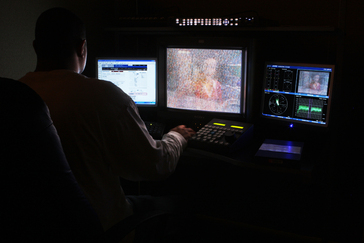Saturation Point?
By Todd Longwell
The Hollywood Reporter, Emmy Watch Crafts 2005

To see how drastically the look of television has changed during the past quarter-century, watch a vintage episode of "Starsky & Hutch" back-to-back with one of today's primetime police procedurals. Visually, they have about as much in common as granddad's home movies do with the "Star Wars" films — and it's the new shows that look like they were shot on Super 8.
"On (FX's) 'The Shield,' whites are all blowing out (and) the grains are swimming," says Pat Sandston, head of postproduction at Jerry Bruckheimer Films and Jerry Bruckheimer Television, a company known for visually distinctive shows. "If you had shown that on television 10 years ago, everybody would have thought it was a mistake."
But is there a point at which oversaturation, desaturation, blurring of backgrounds, heightening of hues and other tricks of the telecine and digital intermediate become too much for TV viewers? For the sixth and final season of the NBC drama "Third Watch," producers shot on 16mm stock to give the show a gritty, grainy look that Level 3 senior colorist Fred Eldridge enhanced in post by boosting contrast and dialing back saturation.
But is there a point at which oversaturation, desaturation, blurring of backgrounds, heightening of hues and other tricks of the telecine and digital intermediate become too much for TV viewers? For the sixth and final season of the NBC drama "Third Watch," producers shot on 16mm stock to give the show a gritty, grainy look that Level 3 senior colorist Fred Eldridge enhanced in post by boosting contrast and dialing back saturation.
"We were very excited by that look and very happy with it, particularly the executive producer Chris Chulack and the director of photography Glenn Kershaw," Eldridge says. "Unfortunately, midway through the season, NBC insisted we switch back to 35mm."
Eldridge believes that the network's objections were more technical than aesthetic.
"I think they felt that the resolution of 16mm wasn't of a high enough standard to meet the needs of high-definition broadcasting," Eldridge says. "If you watched the show in high-definition, you really saw the difference, but if you watched a standard NTSC broadcast, it probably wasn't as noticeable."
Are network executives overreacting? Before the visual extremism of TV dramas like CBS' "Cold Case" became common, audiences were exposed to it through films and numerous commercials and music videos.
"When they first started with all the hand- held camerawork on (ABC's long-running drama) 'NYPD Blue,' people were saying: 'Oh my God! It's too crazy for television!'" Sandston says. "Then it became kind of the norm — and I think that's what's happening with color. As we get more and more feature and commercial directors and (directors of photography) working in television, they're bringing that aesthetic to the medium — and it's paying off."
